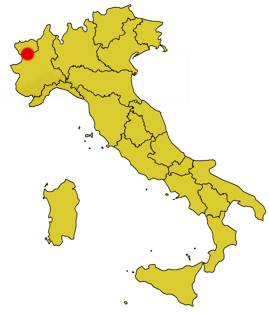Gran Paradiso National Park
| Parco nazionale del Gran Paradiso Parc national du Grand-Paradis | |
|---|---|
 | |
 Location of park | |
| Coordinates | 45°30′10″N 7°18′36″E / 45.50278°N 7.31000°E |
| Area | 703 km2 (271 sq mi) [1] |
| Established | 1922 |
| Governing body | Ministero dell'Ambiente |
| www | |
Gran Paradiso National Park (
History
In the early 19th century, due to hunting, the Alpine ibex survived in the Gran Paradiso and Vanoise area. Approximately 60 individual ibex survived, here.
In 1920 Victor Emmanuel II's grandson
Geography


The park is located in the
Flora

The park's woods are important because they provide shelter for a large number of animals. They are a natural defence against
At higher altitudes, the trees gradually thin out and there are alpine pastures. These pastures are rich in flowers in the late spring.
Fauna


There are more than 100 bird species in the park, including Eurasian eagle-owl, rock ptarmigan, alpine accentor, and chough. Golden eagles nest on rocky ledges, and sometimes in trees. Wallcreeper are found on steep cliffs. There are black woodpeckers and nutcrackers in the park's woodlands.[4]
The park supports many species of butterflies including apollos, peak whites, and southern white admirals.[4]
References
- ^ a b "Gran Paradiso National Park". World Database on Protected Areas. Archived from the original on 2006-08-28. Retrieved 2008-03-12.
- ^ a b c d e "Parco Nazionale del Gran Paradiso". Protected Areas and World Heritage Programme. Archived from the original on May 10, 2008. Retrieved 2008-03-12.
- ^ ISBN 1-85284-231-8.
- ^ ISBN 0-691-12219-9.
- ISBN 0-8018-5789-9.
- ISBN 978-0-7546-4801-7.
- ISBN 978-0822946359.
- ^ a b c d "The Parc environments". Parco Nazionale Gran Paradiso. Archived from the original on 2012-03-29. Retrieved 2008-03-12.
- ^ a b Beaumont, Peter (2005-01-30). "Have skis, will travel". The Observer. Retrieved 2008-03-12.
- ^ ISBN 1-84064-188-6.
- ISBN 2-8317-0612-2.
- ^ a b c "The woods". Parco Nazionale Gran Paradiso. Archived from the original on 2012-03-29. Retrieved 2008-03-12.
- ^ "The rocky environments". Parco Nazionale Gran Paradiso. Archived from the original on 2012-03-29. Retrieved 2008-03-12.
- ISBN 0-521-59122-8.
External links

